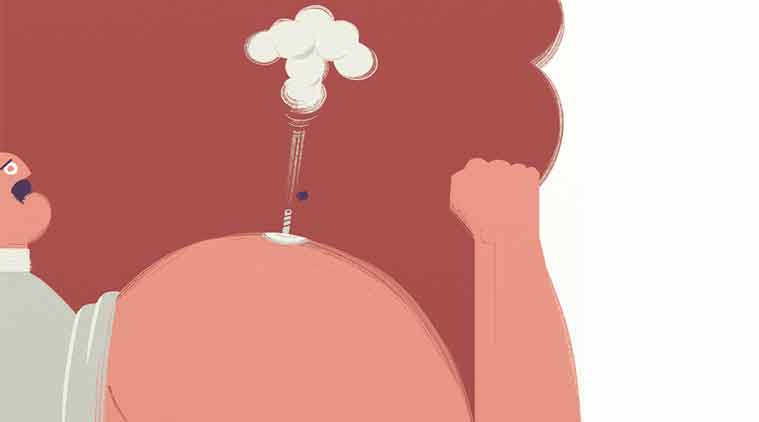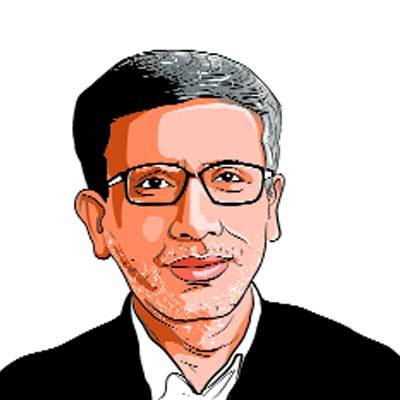Opinion The unimportance of Shahabuddin
He was a creation of the political economy of an earlier time. Bihar has moved on from there.

 For bagging a contract now, there is no need for the mafia to provide muscle power, as the Ranbir Sena or Shahabuddin once did. (Illustration: C R Sasikumar)
For bagging a contract now, there is no need for the mafia to provide muscle power, as the Ranbir Sena or Shahabuddin once did. (Illustration: C R Sasikumar)
Bihar is one of the few states where the intimacies of the mafia and intelligentsia are celebrated in a demonstrative manner. If, of several brothers in a family, one is a muscleman and all others reputed professionals, then the muscleman brother is subsidised by the others. The muscleman brother’s authority in the upwardly mobile family stems from the fact that he is a conduit between the overt and organised operations of his brothers and his own covert world of politics and the underworld. This helps the other brothers not only in promoting their professional graph through the coveted transfer and posting, but also protecting their properties, accumulated through legal or illegal means.
WATCH VIDEO: 5 Things About Shahabuddin’s Criminal Record
It also helps them maintain their hegemony in the lower centres of power, usually a continuation of an erstwhile feudal dominance. In many cases, this protection gets extended to the broader feudal and class interests, since the traditional elites have not generally de-linked themselves from their feudal rural landed interests, unlike in many other states of India. Broadly speaking, this pattern — of graduating from feudal lord to muscleman to lawmaker — is common among the elite fringes of the society in Bihar. It is probably the quickest strategy of buccaneering accumulation for them.
In contrast, musclemen from the backward fringes of society initially acquire their hegemony through the plebian ethos of protecting the poor, but with firearms in command, they often get co-opted into the crime world effortlessly. In the absence of a capitalist culture, their accumulation does not get converted into productive or industrial capital. In the intensity and ferocity of their atrocities, they resemble the traditional elite castes. Thus, even though they are not the defenders of the rural feudal edifice of Bihar, they acquire all the trappings of feudalism in their personal lives and, in the process, even leave the traditional feudal far behind.
This criminalisation led to two mega phenomena in Bihar in the absence of economic growth in the 1980s and ‘90s — one was the Ranbir Sena and the other was Shahabuddin. The former was a social and the latter an individual phenomenon. However, both these phenomena converged on a common agenda: They protected the landed interests of almost the same social group. In the process, they maimed and massacred the subaltern with impunity. Thus, a counter “social diabolism” was introduced to tame the “social justice” movement that had triumphed decisively in the Nineties. One of the erroneous ideas of counter-revolution is that the “democratisation” of society can be throttled or at least contained by strong-arm methods, as was the case with the Ku Klux Klan and the Nazis. Thus, the Ranbir Sena, an organisation of thugs, and Shahabuddin, a vicious criminal, succeeded in Bihar.
Both phenomena had their origins in the nearly stagnant economy of Bihar. In the last decade, however, that economy has leapfrogged significantly. Its growth should not be measured in terms of growth rate or construction of roads and bridges alone. It also has to be seen from the prism of how many local contractors have JCB or Hyaba, roadroller or tractor. Their numbers will be in the thousands now. Even though the major contracts in Bihar are being taken by the outsiders, a new breed of entrepreneurs has emerged in the last decade, who will be the fulcrum of the capitalist transformation of Bihar in future. For bagging a contract now, there is no need for the mafia to provide muscle power, as the Ranbir Sena or Shahabuddin once did. Applications are taken online, where the competition principle is ingrained. These economic activities could flourish because the state is functioning now. Bihar is no more a non-functioning state.
In this backdrop, just as the Ranbir Sena has gone into oblivion, Shahabuddin will also get socially and politically marginalised, irrespective of the direction of the Supreme Court judgment in his case. Remember, both the Ranbir Sena and Shahabuddin had to bite the electoral dust in the last 10 years. Neither Brahmeshwar Mukhiya’s son nor Shahabuddin’s wife could make a breakthrough. This is because neither the Ranbir Sena nor Shahabuddin have a wide social base. Unlike some other musclemen, they have not even acquired the image of a “Robin Hood”. The Robin Hood image stems from the practice of “robbing” the rich and distribution of the “booty” among the poor, but the Ranbir Sena and Shahabuddin were known to have strong support from the feudal oligarchy of south Bihar and the Siwan district. Both tried to muzzle the voice of the people’s movement and had frontal confrontations with the communist movement. While the Ranbir Sena organised several massacres, including the one at Bathani Tola, Shahabuddin was in direct confrontation with the CPI(ML). Most of their victims were from the subaltern classes and castes. It is surprising that a Shahabuddin got political space in a broadly subaltern-centric party like the RJD. In some senses, Shahabuddin’s image is in direct contradiction with that of Lalu Prasad who symbolised the “social justice” aspiration in the Nineties.
During the funeral of the Ranbir Sena chief or after the release of Shahabuddin, the most venomous utterances were reserved for Nitish Kumar. The abusive utterances of the Ranbir Sena or the bravado displayed by Shahabuddin are essentially to galvanise their respective criminal constituencies. Nitish has emerged as a symbol of the authority of the state during the last decade. Even during Nitish’s third term in office, criminals have not got any respite. He is essentially a statist who believes in the rule of law. One should remember that Bihar is not Latin America where the mafiosi can take on the state and the army. Here even a daroga can vanquish the mightiest criminal, if backed by state power and support. After 2005, the state has been on a spree of securing convictions, and high-profile criminals have literally cried for mercy in court. Even Brahmeshwar Mukhiya and Shahabuddin were like chastened schoolboys behind bars. They allegedly conspired in killings from their cell, but they never tried to break jail security.
The resurrection of the state and the breaking into the rural power structures through positive discrimination in panchayati raj institutions was anathema to a section of the elite in Bihar. Thus, the professional and intellectual hegemony that Nitish exercised over the direction of Bihar’s development was taken with a pinch of salt by the traditional elites. No chief minister in post-Independence Bihar, with the possible exception of K.B. Sahay, and to an extent Jagannath Mishra, had intellectual or professional or administrative hegemony over the state system the way Nitish has. The earlier utterances of the Ranbir Sena and the recent fulminations of Shahabuddin against Nitish are essentially the helpless signature tune of that section of the elites which is yet to reconcile with the increasingly organised state of Bihar.



